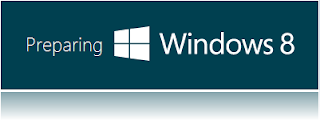Windows 8 is the current release of the Windows operating system, produced by Microsoft for use on personal computers, including home and business desktops, laptops, tablets, and home theater PCs.
Windows 8 uses a new graphical interface based on
Metro design concept. It is a new tile based Start screen very similar
to Windows Phone OS.
New and changed features
New features and functionality in Windows 8 include a faster startup through UEFI integration and the new "Hybrid Boot" mode (which hibernates the Windows kernel on shutdown to speed up the subsequent boot), a new lock screen with a clock and notifications, and the ability for enterprise users to create live USB versions of Windows (known as Windows To Go). Windows 8 also adds native support for USB 3.0 devices, which allow for faster data transfers and improved power management with compatible devices, along with support for near field communication to facilitate sharing and communication between devices.

Windows Explorer, which has been renamed File Explorer, now includes a ribbon
in place of the command bar. File operation dialog boxes have been
updated to provide more detailed statistics, the ability to pause file
transfers, and improvements in the ability to manage conflicts when
copying files.
A new "File History" function allows incremental revisions of files to
be backed up to and restored from a secondary storage device, while Storage Spaces
allows users to combine different sized hard disks into virtual drives
and specify mirroring, parity, or no redundancy on a folder-by-folder
basis.
Task Manager
has also been redesigned, including a new processes tab with the option
to display fewer or more details of running applications and background
processes, a heat map using different colors indicating the level of
resource usage, network and disk counters, grouping by process type
(e.g. applications, background processes and Windows processes),
friendly names for processes and a new option which allows users to
search the web to find information about obscure processes. Additionally, the Blue Screen of Death has been updated with a simpler and modern design with less technical information displayed.
Hardware and System Requirement :
- Processor: 1 GHz or faster
- Computer Memory: 1 GB (32-bit) or 2 GB (64-bit)
- Hard disk space: 20 gigabytes (GB)
- Graphics card: Microsoft DirectX 9 graphics device with WDDM driver
- tablet or monitor that supports multi-touch
-->
Download Links of the ISO file (x86 and x64)


